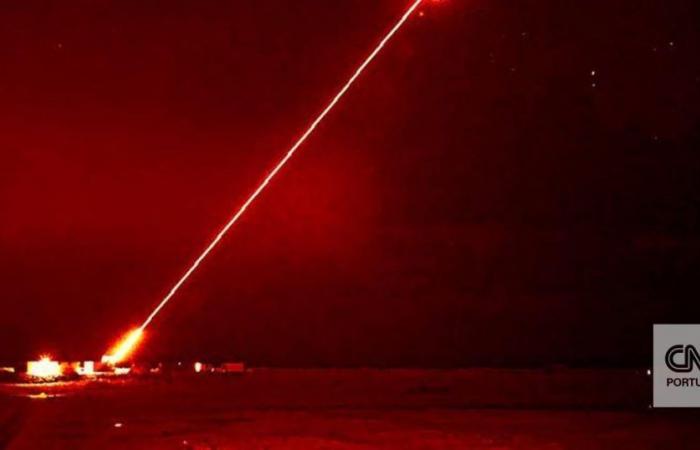
Britain says it has successfully tested the DragonFire laser-directed energy weapons system
Britain this week showed off a new laser weapon that its military says can provide lethal defense against missiles or aircraft for around $13. [12 euros] per shot, potentially saving tens of millions of dollars over the cost of missile interceptors that currently perform this task.
A recently released video of a test of what the UK Ministry of Defense calls DragonFire [à letra, “Fogo de Dragão”]a laser directed energy weapons (LDEW) system, captured what the ministry says was the successful use of the laser against an aerial target during a January demonstration in Scotland.
“It’s a potential paradigm shift for air defense,” the video says, as a bright laser beam streaks across the night sky over a shooting range in the remote Hebrides archipelago, creating a ball of light as it hits the target.
The Ministry of Defense says DragonFire can accurately hit a target as small as a coin “at long distances”, but did not provide details. The exact range of the weapon is confidential.
The laser beam can cut through metal “leading to structural failures or more impactful results if the warhead is hit,” says a statement from the British Ministry of Defense.
It is further claimed that it also shoots down its targets for a small fraction of the price of current air defense missiles.
The Ministry of Defense estimates that the price of a 10-second laser shot is around 13 dollars. In contrast, the Standard Missile-2 used by the United States Navy for air defense costs more than two million dollars [1,85 milhões de euros] per shot.
“It has the potential to be a long-term, low-cost alternative to certain tasks that missiles currently perform,” a January statement from the UK Ministry of Defense said.
The cost of air defense missiles has become a hot topic in defense circles in recent years, as low-cost drones have shown their effectiveness on battlefields in Ukraine and in Houthi rebel attacks on commercial and military ships. in the Red Sea and the Gulf of Aden.
Analysts have questioned how long the US, UK and their partners can continue to use multimillion-dollar missiles against Houthi drones, which in some cases can be purchased for much less than $100,000. [92 mil euros].
However, Western allies’ expensive air defense systems have been crucial to Ukraine’s ability to defend itself from Russian missile and drone attacks.
A Dragonfire laser-directed energy weapons system on display at the DSEI arms show, September 10, 2019, in London, England. Leon Neal/Getty Images
“Low-cost drones and missiles have changed the economic calculus of attack and defense in favor of those using large volumes of cheap unmanned systems and munitions to overwhelm more sophisticated air and missile defenses,” wrote James Black, assistant director of defense and security think tank RAND Europe, in a blog in January.
DragonFire could help tip that calculation back in the UK’s favor, Black said.
“This type of cutting-edge weaponry has the potential to revolutionize the battlespace by reducing reliance on expensive munitions,” UK Defense Secretary Grant Shapp said in January following the DragonFire test.
Unproven and limitations
But Black and others note that lasers like the DragonFire have not yet been tested on the battlefield and will have limitations.
Last month, Iain Boyd, director of the Center for National Security Initiatives at the University of Colorado, wrote for The Conversation, which listed some of the problems with lasers.
Rain, fog and smoke scatter the light beams and reduce their effectiveness; laser weapons release a lot of heat, which is why large cooling systems are needed; mobile lasers, mounted on ships or planes, need to recharge their batteries; and the lasers must remain fixed on moving targets for up to 10 seconds to pierce them, Boyd said.
The British are not the first to develop a laser capable of shooting down an aerial target.
In 2014, the US Navy successfully tested and deployed a laser weapons system on the USS Ponce in the Persian Gulf.
The system was capable of engaging drones, small aircraft and small boats. In 2020 and 2021, the Navy tested a more advanced laser system on the USS Portland.
In 2022, a laser system was installed on the guided missile destroyer USS Preble. That system is still in the testing phase, Rear Adm. Fred Pyle, director of the Navy’s Surface Warfare Division, said at a symposium in January, according to Breaking Defense.
Also in 2022, the US Navy successfully tested a high-energy laser system against a target representing a cruise missile.
But a Navy account of that test said there was no plan to put it in the hands of warfighters, adding that it “offers a glimpse into the future of laser weapons.”
A 2023 report from the US Government Accountability Office (GAO) noted the Pentagon’s success in testing laser weapons but said it needs to do more to get them to troops, including figuring out their exact missions and acquisition strategies.
“The Department of Defense has long noted the existence of a gap – sometimes referred to as the “valley of death” – between its development and acquisition communities that impedes technological transition,” says the GAO report. .
But British defense leaders say there is a new imperative to put lasers on the modern battlefield and there is no time to waste in doing so.
“In a world of evolving threats, we know that our attention must focus on achieving capabilities for the warfighter and we will look to accelerate this next phase of activity,” said Shimon Fhima, director of strategic programs at the UK Ministry of Defense, in a statement.
Tags: Air defense euros shot Dragon Fire Lasers Revolutionize Military Fights Enemy Missiles Drones
--




